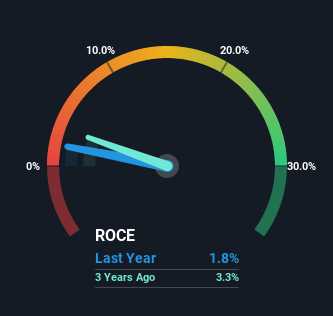- Malaysia
- /
- Construction
- /
- KLSE:SYCAL
Investors Could Be Concerned With Sycal Ventures Berhad's (KLSE:SYCAL) Returns On Capital

To avoid investing in a business that's in decline, there's a few financial metrics that can provide early indications of aging. More often than not, we'll see a declining return on capital employed (ROCE) and a declining amount of capital employed. This indicates the company is producing less profit from its investments and its total assets are decreasing. In light of that, from a first glance at Sycal Ventures Berhad (KLSE:SYCAL), we've spotted some signs that it could be struggling, so let's investigate.
Understanding Return On Capital Employed (ROCE)
For those that aren't sure what ROCE is, it measures the amount of pre-tax profits a company can generate from the capital employed in its business. Analysts use this formula to calculate it for Sycal Ventures Berhad:
Return on Capital Employed = Earnings Before Interest and Tax (EBIT) ÷ (Total Assets - Current Liabilities)
0.018 = RM6.0m ÷ (RM477m - RM149m) (Based on the trailing twelve months to March 2022).
Therefore, Sycal Ventures Berhad has an ROCE of 1.8%. Ultimately, that's a low return and it under-performs the Construction industry average of 5.4%.
See our latest analysis for Sycal Ventures Berhad

While the past is not representative of the future, it can be helpful to know how a company has performed historically, which is why we have this chart above. If you want to delve into the historical earnings, revenue and cash flow of Sycal Ventures Berhad, check out these free graphs here.
How Are Returns Trending?
There is reason to be cautious about Sycal Ventures Berhad, given the returns are trending downwards. To be more specific, the ROCE was 3.6% five years ago, but since then it has dropped noticeably. Meanwhile, capital employed in the business has stayed roughly the flat over the period. Since returns are falling and the business has the same amount of assets employed, this can suggest it's a mature business that hasn't had much growth in the last five years. So because these trends aren't typically conducive to creating a multi-bagger, we wouldn't hold our breath on Sycal Ventures Berhad becoming one if things continue as they have.
On a side note, Sycal Ventures Berhad has done well to pay down its current liabilities to 31% of total assets. That could partly explain why the ROCE has dropped. What's more, this can reduce some aspects of risk to the business because now the company's suppliers or short-term creditors are funding less of its operations. Some would claim this reduces the business' efficiency at generating ROCE since it is now funding more of the operations with its own money.
Our Take On Sycal Ventures Berhad's ROCE
In the end, the trend of lower returns on the same amount of capital isn't typically an indication that we're looking at a growth stock. Long term shareholders who've owned the stock over the last five years have experienced a 31% depreciation in their investment, so it appears the market might not like these trends either. That being the case, unless the underlying trends revert to a more positive trajectory, we'd consider looking elsewhere.
If you want to know some of the risks facing Sycal Ventures Berhad we've found 3 warning signs (1 can't be ignored!) that you should be aware of before investing here.
While Sycal Ventures Berhad isn't earning the highest return, check out this free list of companies that are earning high returns on equity with solid balance sheets.
New: Manage All Your Stock Portfolios in One Place
We've created the ultimate portfolio companion for stock investors, and it's free.
• Connect an unlimited number of Portfolios and see your total in one currency
• Be alerted to new Warning Signs or Risks via email or mobile
• Track the Fair Value of your stocks
Have feedback on this article? Concerned about the content? Get in touch with us directly. Alternatively, email editorial-team (at) simplywallst.com.
This article by Simply Wall St is general in nature. We provide commentary based on historical data and analyst forecasts only using an unbiased methodology and our articles are not intended to be financial advice. It does not constitute a recommendation to buy or sell any stock, and does not take account of your objectives, or your financial situation. We aim to bring you long-term focused analysis driven by fundamental data. Note that our analysis may not factor in the latest price-sensitive company announcements or qualitative material. Simply Wall St has no position in any stocks mentioned.
About KLSE:SYCAL
Sycal Ventures Berhad
An investment holding company, operates as a contractor for building, infrastructure, and civil construction works in Malaysia.
Excellent balance sheet with proven track record.
Market Insights
Community Narratives



